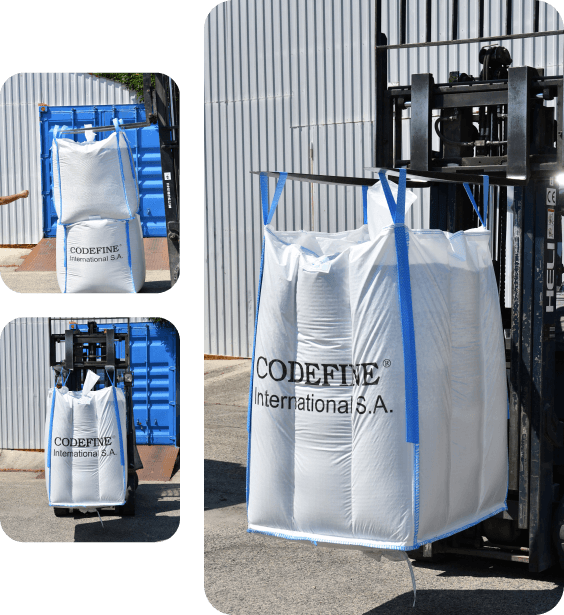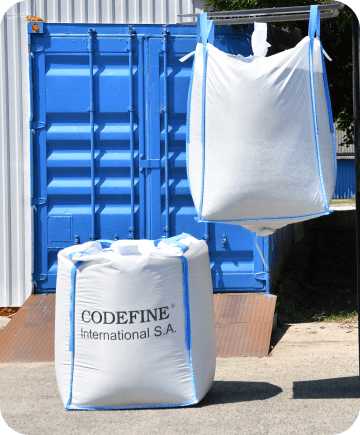Home » Posts Page » Blog » Codefine » How to Stack Bulk Bags Safely: Techniques for Secure and Efficient Storage

Successful stacking begins with understanding the containers themselves. FIBC (Flexible Intermediate Bulk Container) bags aren’t uniform products; they vary significantly in design and purpose. Type C and Type D bags provide crucial static protection when storing flammable materials, a critical consideration for preventing incidents with substances like grain dust. The structural integrity of bags dramatically affects stacking stability, with reinforced corners and robust lifting loops offering superior stacking performance.
Bag geometry plays a surprisingly significant role in stacking success. Cube-shaped FIBCs, with their flat surfaces and right angles, naturally create more stable configurations than their rounded counterparts. The flat bottom design establishes a solid foundation for subsequent layers, eliminating the instability issues inherent with curved bases. Many warehouses transition exclusively to cubic FIBCs after experiencing stability challenges with alternative shapes.
The contents themselves influence stacking dynamics over time. Materials settle some compact heavily while others shift unpredictably. Agricultural products might gradually compress, causing balanced stacks to tilt dangerously over several days. Chemical powders could migrate within bags, creating uneven weight distribution that compromises stability.
Manufacturer specifications exist for good reason. Their stacking height recommendations stem from extensive testing under various conditions. These guidelines identify each bag type’s structural limits before potential failure occurs-treating them as optional suggestions risks costly accidents.
Safety remains paramount in all stacking operations. The Safe Working Load (SWL) rating deserves absolute respect; exceeding this threshold courts disaster. Manufacturers determine these limits through rigorous testing protocols designed to identify true breaking points-not theoretical guesses.
Stack consistency proves crucial for long-term stability. Creating configurations with uniform weights and contents eliminates problematic pressure points that develop when mixing heavy and light containers. While issues might not manifest immediately, inconsistent stacking often leads to failures that emerge days after initial configuration.
Proper sealing of all FIBC bags, polypropylene containers, and liner systems before placement prevents material leakage that can damage multiple stack layers. Chemical products demand particular attention, as even minor leaks potentially compromise entire storage areas.
Warehouse-specific constraints should govern practical height limitations. Ceiling clearances, lighting systems, sprinkler configurations, and ventilation designs all impose real-world restrictions that might require more conservative stacking heights than theoretical maximums.
Designated stacking zones with clear signage serve multiple safety functions. These marked areas prevent accidental collisions with forklifts and other equipment while discouraging impromptu stacking in unsuitable locations. Regular staff training reinforces proper techniques and prevents knowledge gaps that lead to dangerous improvisation.
Column stacking represents the most straightforward approach-placing bags directly atop one another. This technique works particularly well with stable products that maintain consistent form without internal shifting.
Precise corner alignment becomes essential when employing column configurations. Even weight distribution prevents gradual tilting issues, though keeping columns relatively short (typically 2-3 bags maximum) remains advisable for most applications. While column stacking maximizes vertical space utilization, it sacrifices some stability compared to alternative methods.
This approach proves especially valuable for temporary storage scenarios. Agricultural warehouses and construction sites, where frequent access requirements exist, benefit from column stacking’s simplicity. Facilities that maintain high inventory turnover rates often prefer this method since materials rarely remain stored long enough for stability problems to develop.
When stability takes priority, pyramid stacking offers superior protection against collapse. This technique places progressively fewer bags on each ascending level, creating a broader base with reduced pressure on upper containers.
The method begins with a solid foundation layer. Each subsequent tier positions bags slightly inward from the edge below, creating a stepped appearance culminating in a single bag at the peak. This inward progression prevents the edge-sliding common failure point in poorly designed stacks.
Long-term storage applications benefit tremendously from pyramid configurations. Mining products, chemicals, and other materials where stability outweighs space efficiency find optimal protection with this approach. The stepped design also enhances accessibility, allowing workers to retrieve higher bags with reduced risk compared to vertical column arrangements.
Block stacking combines column efficiency with pyramid stability through strategic interlocking patterns. The technique creates interconnected bag groups that resist sliding while maintaining reasonably efficient space utilization.
The approach resembles bricklaying bag bridges the seam where two bags meet in the layer below. This pattern dramatically increases stability compared to simple columns while offering better space efficiency than pure pyramid configurations.
Pharmaceutical products and food ingredients often benefit from block stacking’s balanced attributes. Operations requiring both stability and moderate density find this method particularly valuable, as it permits reasonable inventory visibility without dismantling entire configurations during stock-taking procedures.
Specialized equipment significantly enhances stacking safety and efficiency across operations.
Purpose-designed forklifts with bag-specific attachments distribute lifting pressure evenly throughout the container. Spread-fork designs and specialized lifting frames prevent punctures and tears during handling. While representing a higher initial investment, these specialized tools often pay for themselves by preventing product damage and associated cleanup costs.
Support frames create vertical stability for bags susceptible to compression deformation. These structures help maintain consistent weight distribution throughout stacked configurations, dramatically reducing damage rates in vulnerable materials.
Foundation stabilizers anchor bottom layers securely, creating reliable platforms for subsequent tiers. These devices prevent shifting at the critical base level where stability problems typically originate.
Environmental factors significantly influence stack integrity over time.
Indoor storage protects bags from degradation caused by weather exposure. Ultraviolet radiation, moisture infiltration, and temperature fluctuations all accelerate material breakdown, particularly concerning for bags intended for extended storage periods.
Proper flooring provides essential foundation support. Concrete surfaces offer optimal stability compared to uneven or compressible alternatives that introduce unpredictable settling patterns. Even minor floor irregularities potentially compromise stack integrity over time.
Temperature control preserves both container materials and contents, particularly critical for agricultural goods, chemicals, and food products. Temperature fluctuations alter how materials behave within bags, potentially creating unexpected pressure points that destabilize configurations.
Adequate ventilation prevents moisture accumulation that weakens containers and potentially damages contents. Proper airflow becomes especially important in humid environments or long-term storage applications where condensation risks increase.
Sunlight exposure accelerates material degradation even in indoor settings. Ultraviolet radiation breaks down bag fibers over time, reducing their load-bearing capacity. Strategic placement away from windows and skylights extends container lifespan and maintains stacking integrity.
A thorough floor evaluation establishes appropriate stacking zones. While surfaces may appear level visually, proper measurement tools often reveal subtle irregularities th
Regular inspection routines prevent developing problems from becoming catastrophic failures.
Daily visual assessments identify early warning signs like leaning, bulging, or material displacement. These quick checks catch subtle changes before they escalate into dangerous conditions, allowing corrective action while problems remain manageable.
Weekly stability evaluations provide hands-on verification of stack integrity. Strategic pressure testing at key points reveals weaknesses not apparent through visual inspection alone, offering deeper insight into developing issues.
Documentation of container damage creates valuable institutional knowledge. Recording tears, stretched fabric, and weakened lift points helps identify patterns that inform future stacking decisions and staff training needs.
Alignment verification confirms that stacks maintain proper geometry over time. Even perfectly constructed configurations potentially shift gradually, with subtle changes signaling potential stability problems requiring attention.
Floor condition monitoring recognizes that substrate changes affect stack integrity. Spills, surface damage, or subtle settling potentially undermine otherwise perfect stacking arrangements from below.
Content behavior observation recognizes how materials change within containers over time. Products settling unevenly create internal pressure points that potentially destabilize entire stacks despite proper external appearance.
Certain errors consistently lead to stacking failures across facilities.
Exceeding height recommendations represents perhaps the most widespread mistake. The temptation to add “just one more layer” frequently results in collapsed stacks, damaged products, and potentially injured personnel.
Mixing container types introduces unpredictable stress points and instability. Different bag designs respond differently under pressure, creating weak points where dissimilar containers meet. Maintaining consistency throughout each stack significantly enhances stability.
Using damaged bags guarantees problems. Compromised lifting loops, torn seams, or weakened materials fail unpredictably under pressure, potentially triggering cascading collapses that destroy entire stacks.
Overlooking floor load capacity limits invites structural failure below stacks. Different warehouse sections potentially have different weight limitations based on construction details-violating these limits risks floor damage or catastrophic breakthrough.
Improper weight distribution, particularly placing heavier bags atop lighter ones, creates inherently unstable configurations prone to tipping. Density considerations should always prioritize placing denser materials at lower levels within stacks.
Blocking essential systems creates unnecessary hazards. Emergency exits, fire suppression equipment, and other critical infrastructure must remain accessible regardless of storage pressures.
Strategic approaches maximize storage efficiency without compromising safety.
Traffic pattern analysis identifies optimal stack placement. Understanding how personnel and equipment move through the facility prevents configurations that impede operational flow, enhancing both safety and efficiency.
Systematic inventory rotation prevents material degradation during storage. First-in-first-out principles apply beyond food products, benefiting most bulk materials by preventing extended storage periods for specific containers.
Standardized methodologies create consistency across operations. When all personnel follow identical stacking protocols, retrieval becomes safer and more predictable across shifts and departments.
Automated systems offer potential advantages for high-volume operations. While representing significant initial investments, these technologies potentially deliver substantial safety improvements and operational consistency that justify their cost over time.
Material segregation prevents cross-contamination while streamlining handling procedures. Designated areas for specific product types enhance both safety and operational efficiency when properly implemented.
Adequate access spacing between stacks facilitates inspection and inventory management. While tight configurations might seemingly increase capacity, they often create inefficiencies when materials need retrieval or examination.
Regular reassessment ensures stacking methods evolve with changing inventory requirements. Methods perfectly suited to past product mixes potentially become suboptimal as operational needs shift, requiring periodic reevaluation and adjustment.
Safe stacking begins with high-quality packaging, and that’s where Codefine delivers. We provide a full range of industrial-grade FIBC bulk bags and container liners designed for secure, efficient handling across agriculture, construction, chemicals, food, and pharmaceuticals.
Our FIBC bags feature reinforced seams, optional electrostatic protection (Types C and D), and customized lifting options to support various stacking techniques—from column to pyramid and block stacking. For bulk cargo shipped in containers, Codefine’s container liners offer a clean, efficient, and protective solution that minimizes contamination and product loss during transport and storage.
Whether you’re optimizing warehouse space or transporting sensitive materials, Codefine’s packaging solutions are built for durability, safety, and operational efficiency.
At Codefine, you’ll find an extensive range of bulk bags available, including quality ventilated designs that will help keep moisture damage to an absolute minimum. Looking for something else? Why not explore our full range of packaging solutions online today? Alternatively, get in touch to discuss your requirements in more detail.
